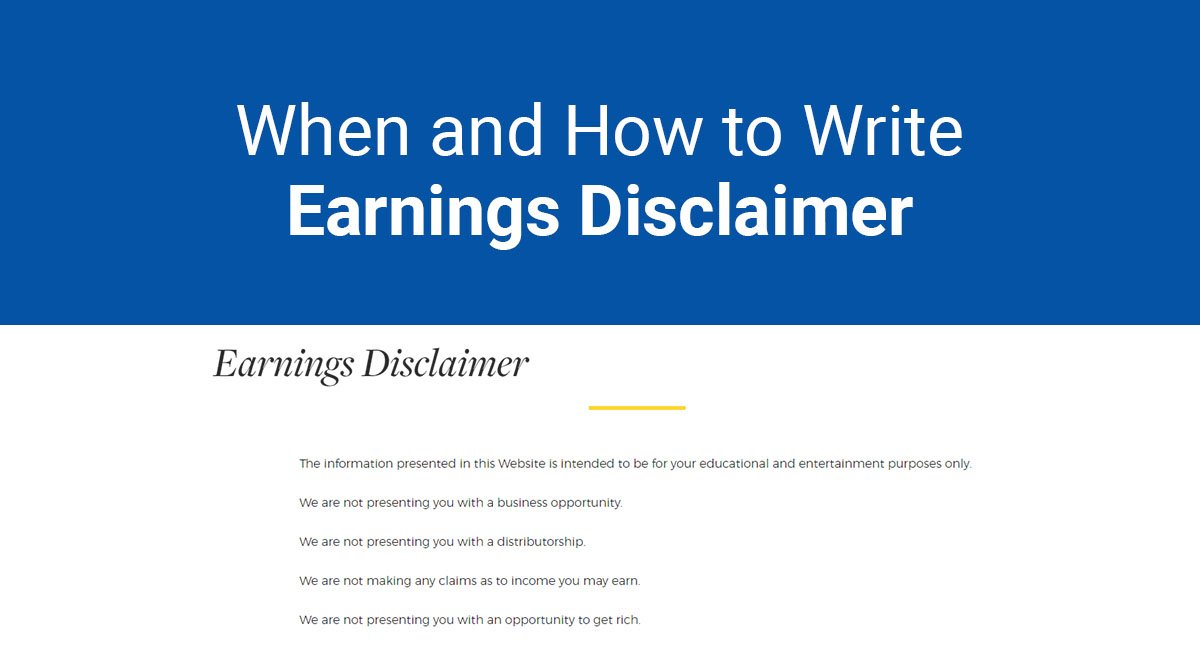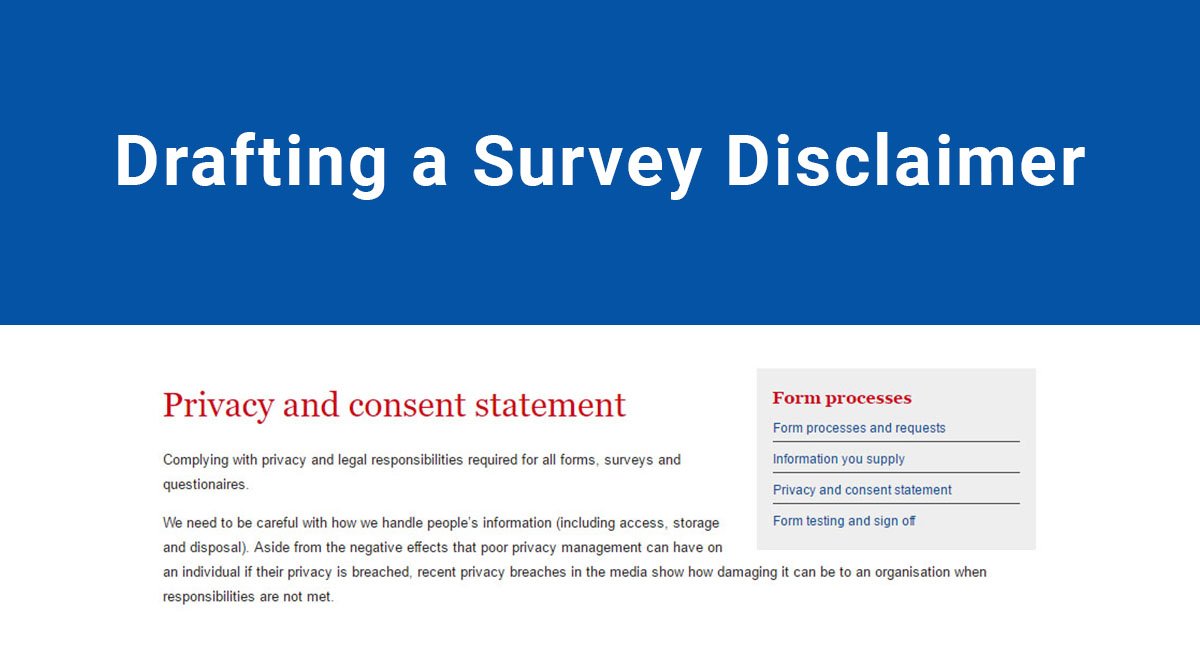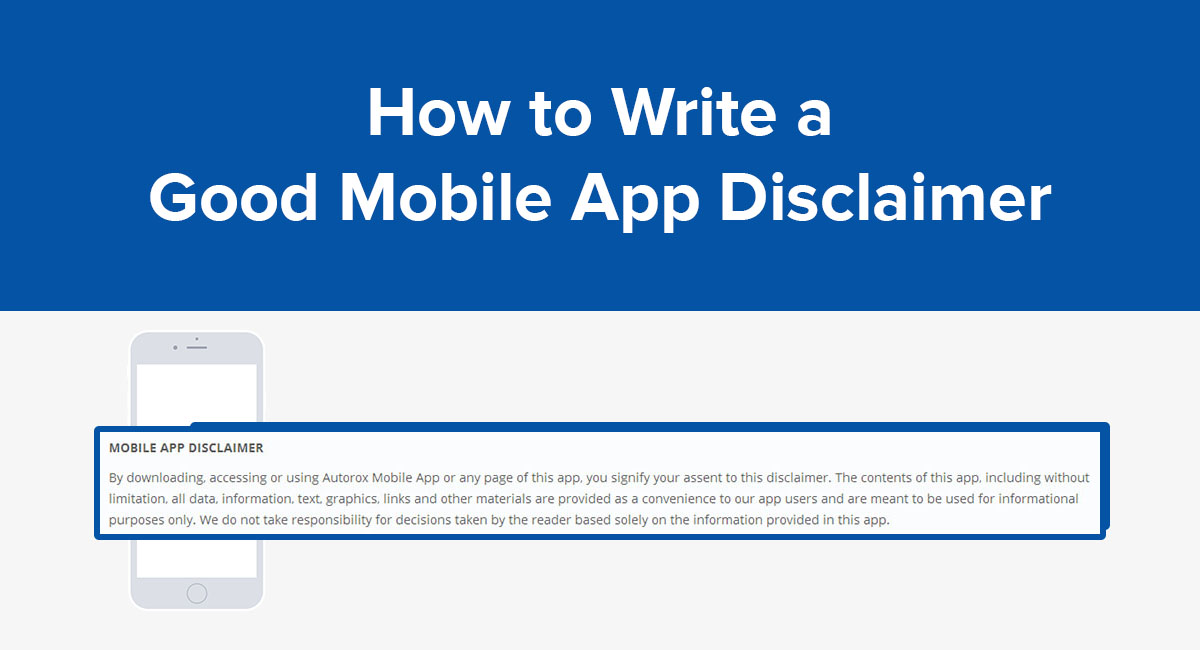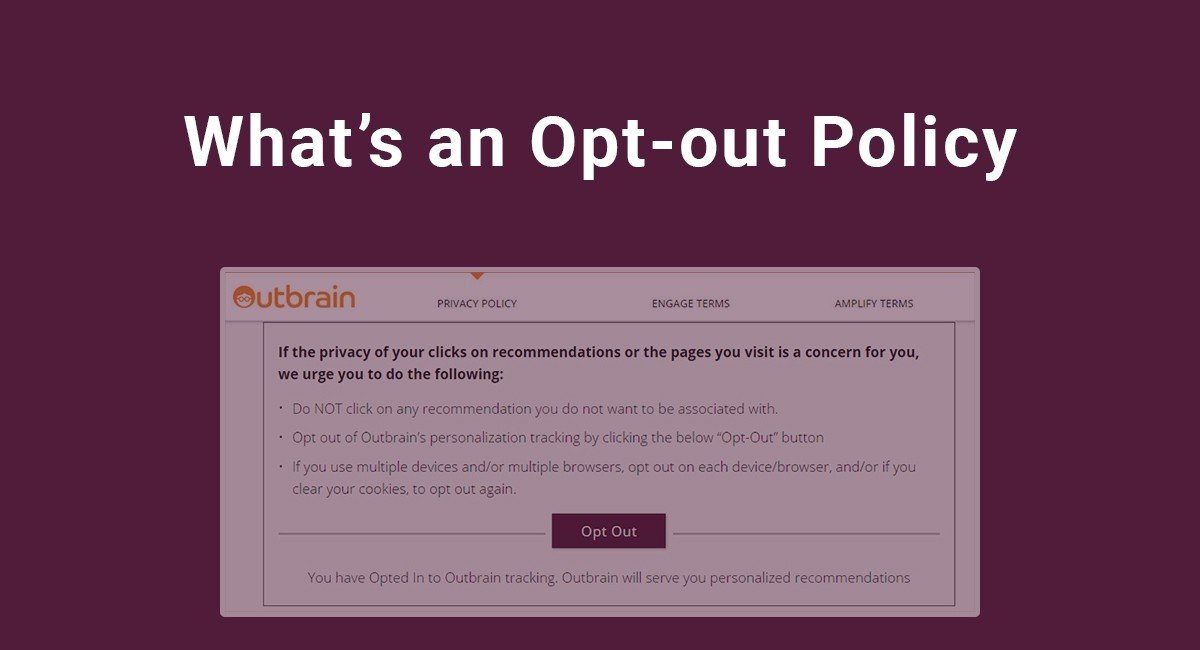Online businesses are hot but not all of them become successful. When you have a product that helps people start their own business, you need to be careful how you present it.
This includes truthful advertising but also a set of provisions known as the Earnings Disclaimer. This disclaimer protects you from liability when users fail to make an effort and fail to meet truth in advertising guidelines.
Here is an overview on Earnings Disclaimers including when and how to draft them.
- 1. What is an Earnings Disclaimer?
- 2. Drafting Earnings Disclaimers
- 2.1. Elements
- 2.1.1. First element: Earnings are estimates, not guarantees
- 2.1.2. Second element: Results are not guaranteed
- 2.1.3. Third element: Past success may not occur again
- 2.1.4. Fourth element: Users must make an effort
- 2.2. Location on website
- 3. Examples
What is an Earnings Disclaimer?
An Earnings Disclaimer is an essential agreement for websites and apps that promote strategies and programs to help users make money.
Generally, it states that income is not guaranteed and that the user must have requisite knowledge and effort to make strategies work.
In the United States, it is a reaction to Federal Trade Commission (FTC) guidelines regarding truth in advertising. In 2000, when Internet advertising became wildly popular, the agency started discussing guidelines for online advertising.
The most comprehensive result of this discussion is the report .com Disclosures: How to Make Effective Disclosures in Digital Advertising which was published in March 2013.
The FTC was concerned with flashy online advertisements that made big claims. It indicated strongly that as with print advertising, online advertisements must be truthful, produce evidence to support claims, and cannot be unfair. Naturally, any guarantees of large income by using a product or strategy purchased by a user falls under these standards.
Earnings Disclaimers should not be confused with Affiliate Disclaimers.
Affiliate Disclaimers let user know that a website owner or blog writer makes money by endorsing particular products or providing links. Earnings Disclaimers focus more on an author or developer's claims regarding their own income strategies.
Basically, you want to avoid the impression of a "get rich quick" scheme as those are frequently exaggerated and people lose money investing in them. Therefore, you want to be careful when drafting an Earnings Disclaimer.
Drafting Earnings Disclaimers
Earnings Disclaimers are very diverse and you will see differences in length, detail, and writing style for each. However, they also contain the same four basic elements.
Elements
The simple Earnings Disclaimer by IncomeDiary.com is a good example for showing the minimum elements of these vital provisions.
Here it is in its entirety:
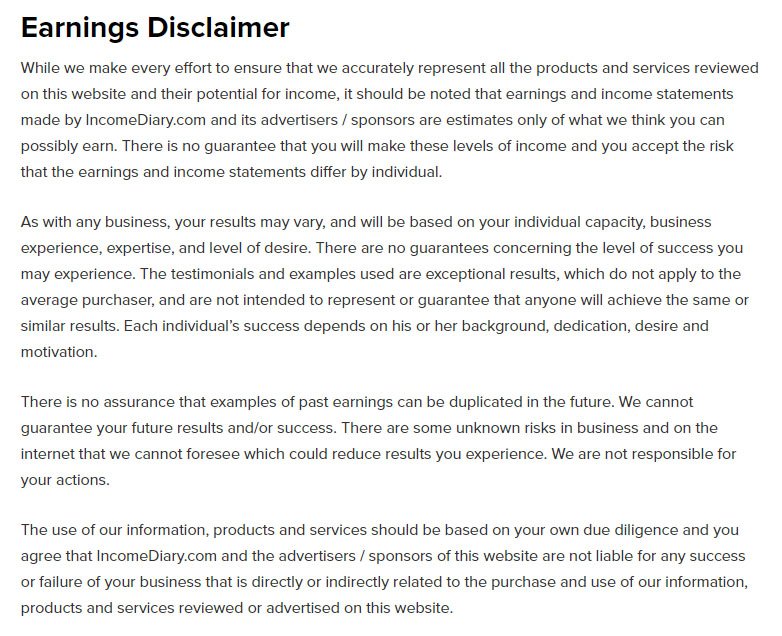
Breaking this apart, you can see each essential element.
First element: Earnings are estimates, not guarantees
If you are making any claims regarding income, you need to make it clear that you only offer estimates regarding--not guarantees. Guaranteeing a first-month income of $5,000 can leave you vulnerable to an unfair trade practices lawsuit if a user only makes $50 in that first month.
One solution is to avoid giving income figures. However, that does not make your product very convincing. So, many developers state that income estimates are just that--estimates and not guarantees.
Here is how IncomeDiary.com addresses this:

Even if your program or product is successful for a majority of users, it is still not a good idea to make guarantees. In this area, understatement is best if you wish to avoid liability.
Second element: Results are not guaranteed
Many income generation programs present testimonials and "success stories." These may be provided by the author of the program or other users.
When you have many of these stories, it can appear misleading. Users may buy your program or product and expect the same results, but fall short on the effort.
That is why it is important to treat your own success, or that of others users, as extraordinary cases. Like with income guarantees, you are better off understating instead of exaggerating.
IncomeDiary.com addresses it this way:

You want to give users a realistic outlook on your program, even if it works for most people. That is the reason for this section.
Third element: Past success may not occur again
Just because a previous user was successful and offered a glowing testimonial does not mean that will happen again for other users. The same is true with your own success--it worked, but it may not work again.
Make this clear in your Earnings Disclaimer as well, just as IncomeDiary.com does:

This allows you to account for changes with the market or the Internet. It is always likely that what worked for you or other users may not work with future participants and you need to cover that situation.
Fourth element: Users must make an effort
Emphasizing user effort is another way to bring them to reality. As stated, you want to avoid the appearance of a "get rich quick" scheme at all costs or you risk users having unrealistic expectations.
The best way to address this element is to communicate that effort and possible success is the responsibility of the user, not the website or your product. IncomeDiary.com admits being helpful but also describes that the user must work, too:

In addition to this provision, avoid terms like "easy money" or "no training." Very few efforts meet those expectations and giving users that impression could be considered false advertising.
Location on website
The FTC was also concerned about disclaimers being hidden on a website. A user should not have to dig to find the Earnings Disclaimer.
The general practice that also works with FTC guidelines is to place a link to the Earnings Disclaimer in the website footer with other agreements. This is where users expect to find essential terms so that allows an easy solution for you.
Also, be aware that while you may have your Earnings Disclaimer in your Terms & Conditions, the FTC does not consider that adequate. You still need to make it a separate document with its own link.
Here is how IncomeDiary.com places the Earnings Disclaimer in the footer next to the Terms of Service and Privacy Policy:
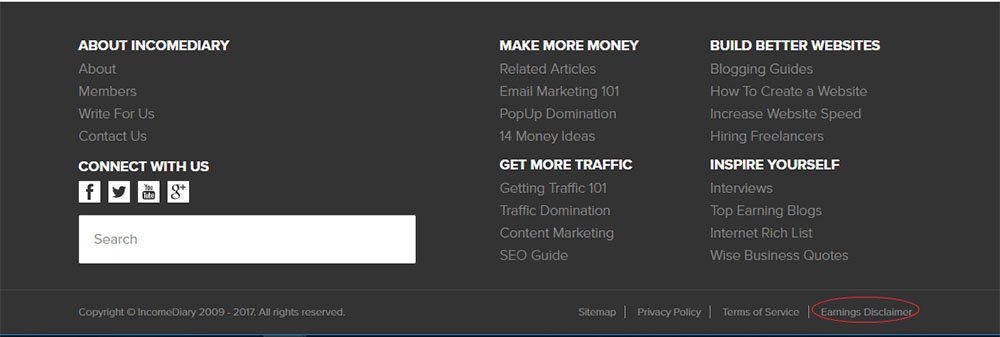
Amy Porterfield, an online marketer, also places the Earnings Disclaimer in the footer with the rest of the online agreements.

These are good examples regarding making an Earnings Disclaimer easy to find. Unfortunately, some web developers make the mistake of hiding the Earnings Disclaimer.
Rick Mulready, who teaches others about effective Facebook ads, offers an Earnings Disclaimer that meets all the elements above:
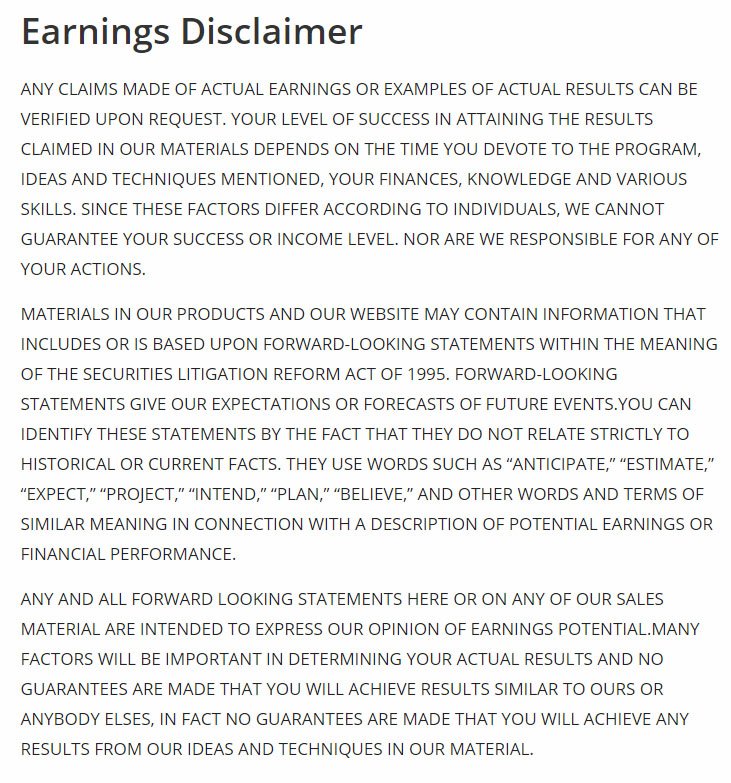
However, there is no link in the footer, even though other agreements are listed:

Presumably, the Earnings Disclaimer becomes accessible when you sign up for coaching or one of his courses.
However, the point of the disclaimer is to alert users before they purchase or subscribe to your product. Even if you give users a chance to review the disclaimers before they sign up, still make the effort to add it to your footer.
That is more likely to meet the FTC's standards regarding conspicuous placement.
Examples
Earnings Disclaimers contain the same material but are often presented differently. Depending on your own writing style, you may want an informal, formal or legalistic approach to yours.
As long as it contains the four elements above, you will likely pass FTC scrutiny.
Smart Passive Income, run by Pat Flynn, presents the Earnings Disclaimer in a conversational style.
The material on this site reflects Flynn's experience as the founder and does not seem to emphasize testimonials.
So, the Earnings Disclaimer focuses more on the role of individual effort rather than claimed income figures and how that worked for Flynn.
It starts off with no guarantees:
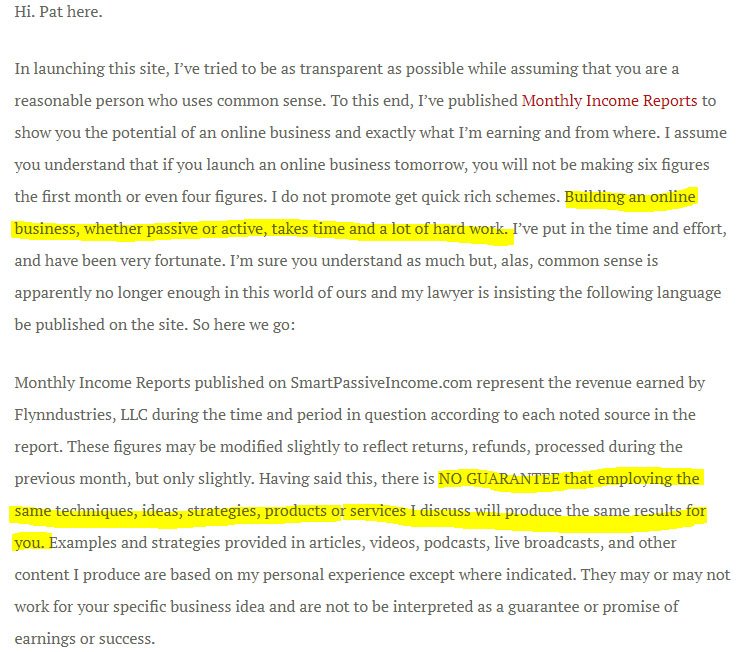
Then it ends emphasizing effort and having a good idea in the first place. Success is never guaranteed:
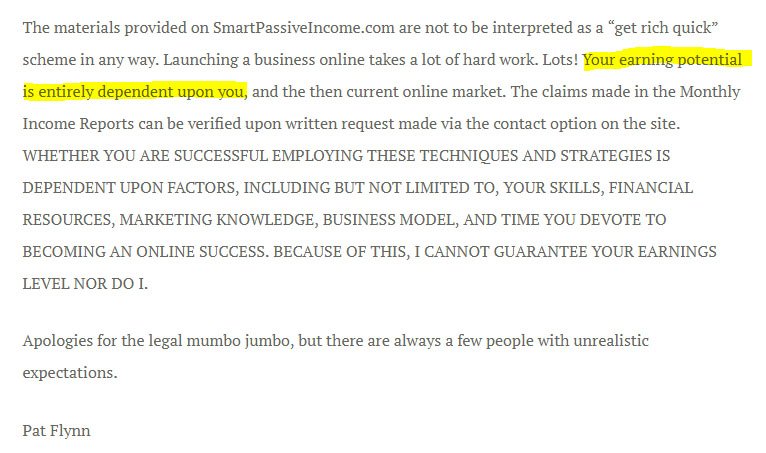
While it is very subtle, this Earnings Disclaimer meets the elements. There is no guarantee of future earnings, users must make an effort, and the founder's past success is not guaranteed for everyone.
Also, his condemnation of "get rich quick" approaches makes it clear he does not fall under that category or convey that impression.
Amy Porterfield also offers an easily comprehended Earnings Disclaimer. It meets all the elements and elaborates to further separate her advice from the efforts of her podcast listeners.
It starts with a very clear statement of what the website does not offer:
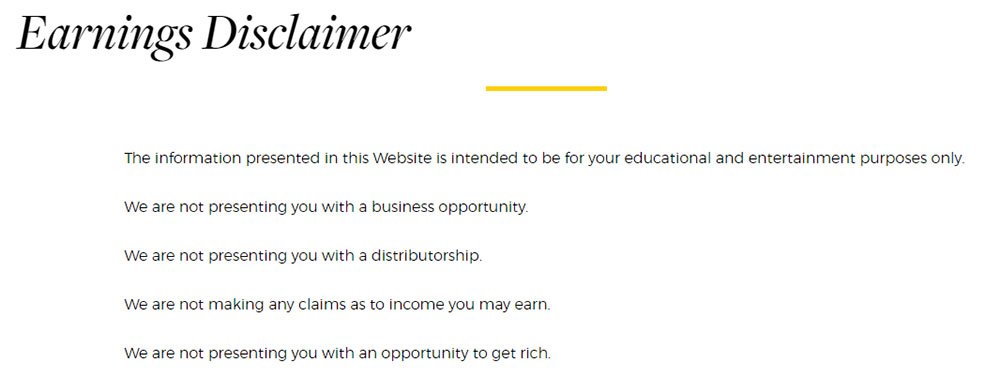
The rest of the Earnings Disclaimer emphasizes effort, knowledge, and the lack of any income guarantees:
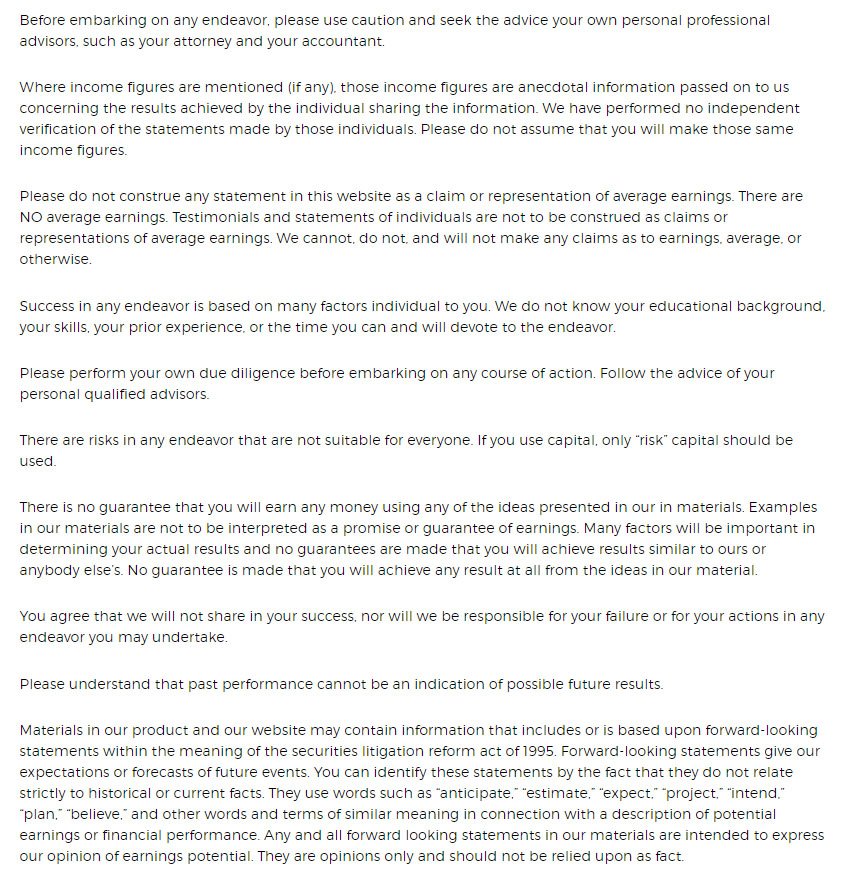
You see more elaboration from Porterfield because that is likely within her comfort level.
If you feel the need to explain or elaborate, go ahead, but be careful not to limit what you disclaim. Consider emphasizing effort if you feel a need to be more specific.
Digital Altitude presents a very comprehensive Earnings Disclaimer. It starts with the personal nature of results and how there are no guarantees of income. In fact,it declines to even indicate average earnings:
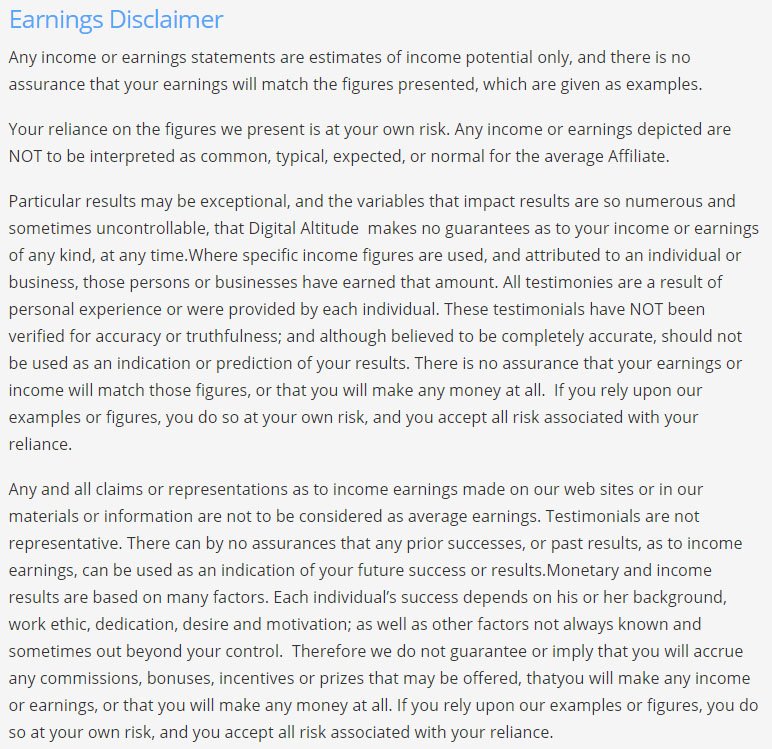
It continues this sentiment by explaining there is risk involved and products exist only for education and information. Users are expected to perform their own due diligence:
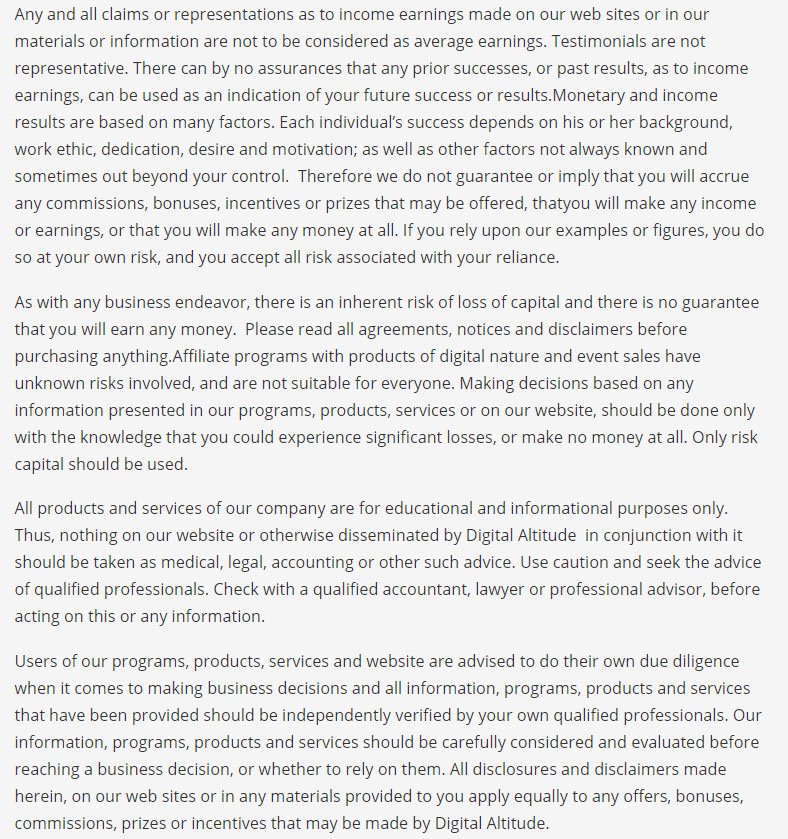
Finally, it ends with explaining that participation constitutes acceptance of these terms and removes responsibility on the part of Digital Altitude:
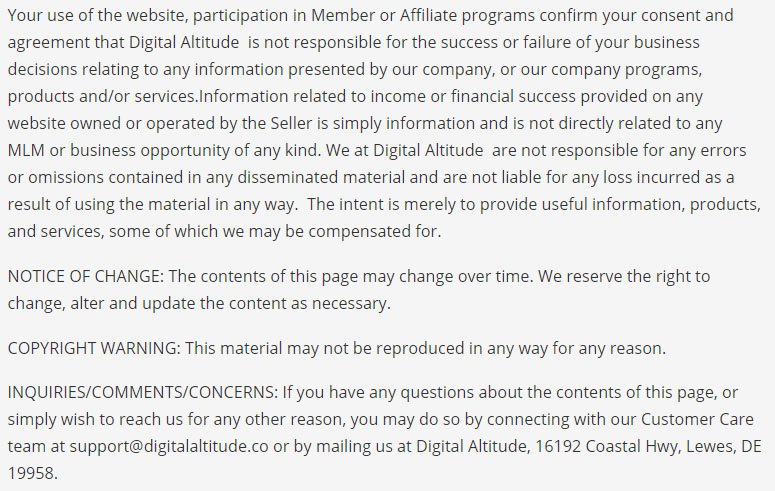
Digital Altitude offers information but also tools meant to enhance online results. Since it offers complex products, it likely felt it needed more protection in its Earnings Disclaimer--thus its detailed nature.
When drafting your Earnings Disclaimer, start with the basic four elements. From there, you can decide where to elaborate. You may keep it simple, like in the IncomeDiary.com examples or become more complex, as with Digital Altitude. Amy Porterfield chooses a disclaimer that falls into the middle.
Once finished, make it available in two places. First, the header or footer of your website right next to links to your Terms & Conditions, Privacy Policy, and other agreements.
Next, integrate it as a link during the purchase and checkout process so users have another chance to look it over.
Taking this approach assures you meet FTC guidelines and avoid misleading users. This not only keeps you in regulatory compliance but also enhances your goodwill.
Honesty is the best policy especially when it comes to income for not only the FTC but also attracting users to your product.

Comprehensive compliance starts with a Privacy Policy.
Comply with the law with our agreements, policies, and consent banners. Everything is included.
